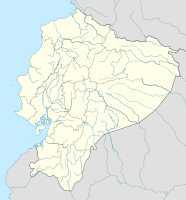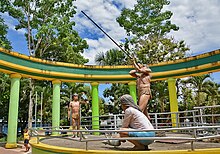Tena
| Tena | ||
|---|---|---|
|
Coordinates: 0 ° 59 ′ S , 77 ° 49 ′ W Tena on the map of Ecuador
|
||
| Basic data | ||
| Country | Ecuador | |
| province | Napo | |
| City foundation | 1560 | |
| Residents | 19,898 | |
| Detailed data | ||
| surface | Canton: 3,895 | |
| height | 598 m | |
| Website | ||
Tena (actually San Juan de los Dos Ríos del Tena ) is a city in Ecuador . It is the capital of the province of Napo and the canton of Tena in the Amazon basin . The city has 19,898 inhabitants (2005 estimate) and is 598 m above sea level at the confluence of the Río Tena with the Río Pano and the Río Misahuallí .
history
The official founding date of Tena is November 15, 1560 . The founding is attributed to Gil Ramírez Dávalos , the then governor and captain general of Quito, or his captain Bartolomé Marín. The first settlement of Tena probably originated as a mission post for the Jesuits in the Amazon region around Archidona, which was founded in 1560 .
At the time, the region was inhabited by indigenous groups that are grouped under the name Quijos . They refused to colonize and proselytize by the Spaniards, which was accompanied by economic exploitation and disrespect for traditional sanctuaries. Under their general Jumandi , the Quijos attacked the settlement Archidona near Tena in a well-organized action in 1578 and completely destroyed it, killing all residents. The resistance could not last long, however, Jumandi was captured after an attack on Baeza and tortured to death in Quito. Today a monument in Tena commemorates the chief. The place Tena was insignificant until the end of the 19th century.
In 1884 Tena became the capital of the new canton Napo (since 1969 canton Tena) in the province of Oriente established in 1861 . In 1921 the Oriente province was split up and Tena became the capital of the newly created Napo-Pastaza province, which was divided into the Napo and Pastaza provinces in 1959 . Massive population growth did not start until the 1970s, when on the one hand settlers from arid regions in the Andes came to the Amazon lowlands , and on the other hand oil production began there.
present
Tena is located away from the large oil fields and has therefore not experienced such strong growth in contrast to other cities in the Ecuadorian Amazon basin (especially Nueva Loja ). It has an orderly, clean cityscape, which, however, manages without any urban highlights. The city is surrounded by various hills. The most important attraction is the Parque Amazónico , a park with a botanical garden and river beach on a peninsula between the rivers Tena and Pano.
In addition, Tena is the starting point for guided tours into the tropical rainforest that surrounds it (including Sumaco Napo Galeras National Park , named after the Sumaco volcano , the Napo River and the Galeras mountain range ) and is inhabited by indigenous village communities. Rafting tours on the Misahuallí are also popular.
The city also acts as a transshipment center for the agricultural products of the area. It is connected to the capital Quito by a paved road via Baeza; Buses run several times a day. Tena has an airfield, which is not served by scheduled flights.
The private Escuela Superior Politécnica Ecológica Amazónica (Espea) is based in Tena. It was founded in 1997 and offers courses in business administration, tourism, nursing and ethnotherapy, education and law in Tena and other cities in the Amazon basin. Some other universities have branches in Tena.
Canton of Tena
In addition to the capital Tena, the canton Tena, which has an area of 3895 km², also includes the rural parishes of Chontapunta, Ahuano, Puerto Misahuallí, Puerto Napo , Pano and Tálag, which are only sparsely populated due to the tropical rainforest.
Besides tourism, agriculture is the most important source of employment. The most important products include cocoa , tea , coffee , sugar cane , manioc ( yuca ), the products of the oil palm , tobacco and fruits (especially Naranjilla ) and beef . There is also a furniture industry that produces from tropical woods; natural rubber is also extracted and gold panned.
Town twinning
- Santa Clarita , California, USA





